“Art” Smith, Flying at Night, and the 1915 San Francisco World’s Fair
When aviation pioneer and stunt pilot Lincoln Beachey was tragically killed in the early days of the 1915 Panama-Pacific International Exposition (PPIE), organizers grappled with whether or not to schedule additional demonstrations of this dangerous new mode of loco-motion at the San Francisco fair. Three weeks later, Art Smith strapped fireworks to the back of his plane and took off at night for the first of a series of spectacular performances defined by his aeronautical prowess. The stunning visual display presented by Smith thrilled observers by his execution of looping-the-loop, rolling over sideways, and a startling series of spins, drops, and dips.
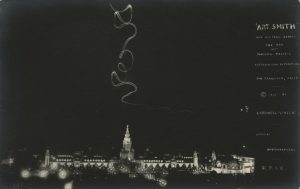
Smith flying his aeroplane offered gripping entertainment for spectators at the fair, and his flights are deserving of visual analysis, as performances in themselves and as the subject of photographic images that recorded his journeys through the air. Smith’s flights provided a welcome respite from troubling news emanating from Europe in the early years of World War I. They also directed the gaze of fair visitors up toward the heavens, where the aviator flew like a comet in the star-filled night sky. Enterprising photographers, who recorded on film the path of Smith’s travel in long single exposures, added additional artistry to the show. Art Smith and His Trail Across the Sky, reproduced as a souvenir postcard by the Cardinell-Vincent Company, depicts the illuminated fairgrounds of the PPIE at night, with the architectural details and contours of the complex softened by the hazy glow of electric lights (fig. 1).
Above the glimmering city, two thin white lines tracking the wings of Smith’s biplane are rendered on the flat, dark background. Looping erratically down toward the Tower of Jewels, the two threads of light merge into one and veer right toward the far side of the image, where the outline of an illuminated aeroplane is about to disappear. While traces of Smith’s actual passage through the air dissipated quickly, photographers such as this one fixed the pathway of his plane in their images. Smith’s flight in a biplane took place over a period of minutes. Photographs of his journey brought together an art in motion with one in stasis; they collapse time and stop it. Smith’s flights, and the photographs that reproduce them, resulted in a multilayered performance that went beyond the thrill of popular entertainment to provide a compelling meditation on new technologies and their engagement with space and time in the early twentieth century.1
“In his biplane,” wrote fair chronicler Frank Morton Todd in his five-volume history, The Story of the Exposition, “Smith performed about all the evolutions that can be done without going into the fourth dimension.”2 Todd, official historian for the PPIE, linked Smith’s technological spectacle to “evolution” and “the fourth dimension.” These ideas, as noted by scholars Linda Dalrymple Henderson and Kathleen Pyne, were understood in very different ways by scientists, artists, and the general public in the early twentieth century.3 The fourth dimension, according to Henderson, was generally thought of as an extrasensory kind of space, a psycho-spiritual plane of existence beyond the empirically experienced material world. This was distinct from scientific associations of the fourth dimension with the special theory of relativity. Evolution usually referred to Herbert Spencer’s blending of scientific evolution with social progress, contends Pyne, rather than to Charles Darwin’s theories of biological conflict. Taking evolution in yet another direction was philosopher Henri Bergson, who argued for “creative evolution,” a means by which humans might reintegrate intellect with intuition, severed during the course of human development. Bergson’s theories were taken up by avant-garde artists in Paris4; they were also receiving critical attention on the western side of the Atlantic, their reach extending to the shores of California.This article builds upon previous literature on world’s fairs,5 expands and explores the intellectual history of the PPIE, and challenges the material parameters of art historical inquiry. It explores the wonder and astonishment evoked by Smith and the visual culture that documented his flights, placing them within the context of three specific cultural concerns of the early twentieth century: the war in Europe; the imaginative possibilities of astronomical science; and philosophical musings about multidimensional space and evolutionary time. Aeroplanes and cameras, the two modes of new technology that played key roles in Smith’s celebrity, provided observers with the means to engage with and rethink these issues in a creative manner. By looking at Smith’s performances, the fair at which he performed, and the photographs that documented his illuminated path through the sky, this article places visual culture at the center of art historical discourse and provides a productive new entryway into these subjects as they were experienced and reimagined at the PPIE in 1915.
A Close and Spectacular Approach to the Realism of War
Aviator Lincoln Beachey had been a main attraction at the PPIE before Smith began his night flights. Considered a “popular hero of his times,” Beachey was dubbed “the eighth wonder of the world” by a consortium of newspaper reporters.6 Hired before the fair opened, he made the first indoor flight ever by taking off and landing in the massive Machinery Palace while it was still under construction. He then inaugurated Opening Day on February 20, 1915, by turning over and over in his plane while releasing white pigeons from hundreds of feet above the fairgrounds. For the next few weeks, he regularly performed such daring feats as flying upside down and looping-the-loop.7 But on March 14, while trying a new monoplane in front of a large crowd, Beachey plummeted into San Francisco Bay.8 The aviator drowned before rescuers could locate and raise his submerged machine, and the fair officials were forced into action in a frantic attempt to manage the public relations disaster that had suddenly fallen from the sky.
There were very few pilots in the United States who could rival Beachey’s prowess. Looping-the-loop was the most daring aeronautic manoeuvre at the time, and anyone seeking to replace him had to be able to do it. Art Smith, by auditioning at night, received the contract.9 Smith’s first flight in San Francisco almost ended in disaster, for the fireworks he hastily purchased upon arrival in the city malfunctioned and set his fuselage on fire. During subsequent demonstrations, he used specially manufactured magnesium flares to produce multicolored threads of light in the darkness without endangering his life.
“Art Smith’s loop-the-loops were a sensation,” biographer Rachel Roberts observed. “Beachey’s flying had been a huge attraction, but nothing was as thrilling as Art’s daring feats, especially his night shows.”10 The Oakland Enquirer reproduced an image of Smith’s performance on July 30. “This remarkable night photograph shows Art Smith and biplane in a spectacular midair gyration,” explained the caption. “It is the first successful attempt of the camera man to register on a photoplate both the stream of fire Smith leaves behind and the machine in which he flies, together with the wonderful lighting of the exhibition.”11 Photography critics thought it one of the best pictures thus far secured, reported the newspaper.
Smith loved the media; he regularly announced new shows and posed for photographers. Using his position to speak publicly on behalf of the aeroplane, he promoted the imaginative potential of this new machine. A serialized story of his life, Art Smith’s Story: The Autobiography of the Boy Aviator, capitalized on the youth of the pilot, his small stature, and impish personality. In it, Smith brashly predicted that “some day [flying] will be no more thrilling than using a telephone. Within a short time—five years perhaps—licenses for aeroplanes will be issued as licenses for automobiles are now.”12
Smith explicitly noted the capability of the aeroplane to overcome everyday notions of space and time. “The greatest barrier between people is distance,” he explained. “Think what fifteen miles meant in the days when the only way to cover them was to walk them step by step… A man lives fifteen miles from his office now, and gets to work every morning on time. Fifteen miles is nothing. Two hundred miles is no more than that to the aeroplane.”13 Smith’s observation acquires added resonance for having been delivered at an international world’s fair. Events like the PPIE compressed and made manifest the entire world and its history within the limited grounds and timeframe of the exposition, argues political theorist Timothy Mitchell.14 Like a world’s fair, the aeroplane made space and time seem increasingly relative.
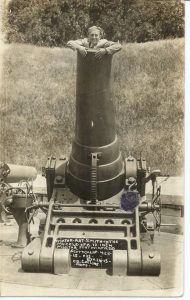
Photographic postcards of Smith, especially a series depicting the pilot clowning around Fort Winfield Scott, an active military base located next to the PPIE, link the aviator’s performances to World War I. For one shot, the diminutive pilot climbed into the muzzle of a twelve-inch mortar, standing in for ammunition to be launched into the air (fig. 2).15 World War I had erupted in May 1914, causing some to assume that the fair would be cancelled. It opened as scheduled, but the sinking of the RMS Lusitania, a civilian ocean liner torpedoed on May 7, 1915 by a German U-boat while traveling from New York to Liverpool, cast a pall on festivities. The attack, which took place during the second month of Smith’s first four-month contract, resulted in the loss of almost 2,000 lives and provoked widespread condemnation.16 Smith’s aerial flights and weaponized persona acquired new resonance in the context of these actions.
The martial implications of Smith’s show were further reinforced by soldiers parading through the fairgrounds, offering artillery demonstrations to interested onlookers. Even though the aviator claimed he did “not believe in war” and expressed his hope that fighting would not come to “peaceful America,”17 preparedness manoeuvres became a regular part of the fair offerings during Smith’s tenure. And despite his pacifist claim, both Smith and the press used military terminology to promote his flights. The USS Oregon, which had served in the Spanish-American War, was one of several battleships anchored in San Francisco Bay for the exposition, and four days before the Lusitania’s demise, on May 3, “Smith circled the war vessel … and discharged two skyrockets straight down at the ship.”18 Later that month (and after the Lusitania tragedy), when organizers decided to blow up an old ferry boat as part of the entertainment program of the fair, newspapers assured readers that the destruction would “be a close and spectacular approach to the realism of war.”19
That same week, Smith produced a bombing effect so realistic that several spectators fainted. According to a report in the San Francisco Examiner, “Smith had been working for several days, thinking up a new ‘shock-producer.’ He decided that a ‘bomb’ performance would be appropriate, so a big can of gun-powder was tied to the back of his keel-piece.”20 A long fuse, running from the explosive to his seat, allowed him to discharge the gun powder at just the right moment. “I’ll show you some real European war stuff now,” the aviator shouted to onlookers as he soared from the Marina at the beginning of the flight.21 Smith both exploited and pacified public fear in California at the beginning of World War I.
Like Smith’s militarized persona, aeroplanes and cameras were inflected by the wartime climate. Airborne vehicles and photographic devices had been used for military reconnaissance and communications since the mid-nineteenth century. Gaspar Félix Tournachon (Nadar) had taken the first aerial photographs from a balloon in 1858,22 and the military was attaching cameras to kites and other flying objects (including pigeons) by the end of the century. The Germans, concentrating on aeroplanes and dirigibles, and the allies, focusing exclusively on the aeroplane, significantly advanced aeronautical science in the early twentieth century.23 Guns and other munitions were attached to these various flying machines at the start of World War I, and Captain John Moore-Brabazon, working in England, developed the first camera specially designed for an aeroplane in 1915.
Cameras are metaphorically linked to weaponry, leading to the development of an evocative set of words—such as load, point, aim, and shoot—that are related to the art of photography. “The camera increasingly served as a surrogate gun by channeling and recoding associated impulses to ‘shoot’ and ‘capture’ in virtual and aesthetic terms,” explains Alan Braddock, who is currently engaged in an art historical study of what he calls “gun vision.”24 Photographers in the nineteenth century used metaphorical names for their inventions to further the association between cameras and guns. Jules Janssen created a revolver photographique to record the transit of Venus across the sun in 1874, and Étienne-Jules Marey, working to improve the precision of sequential photography, designed a fusil photographique, a photographic “rifle,” which he presented in Paris in 1882.25 Modern technologies that became increasingly prevalent in the early years of the twentieth century, guns and cameras both placed power in the hands of the individuals who controlled them.
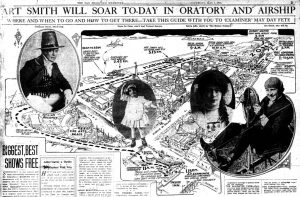
Smith’s aerial or bird’s eye view was also linked to power.26 Landscape painters in the nineteenth century had made effective use of the panoramic and panoptic modes to lay claim to the land, demonstrating the limitlessness of nature and the vastness of its potential.27 This viewpoint, in the words of art historian Sarah J. Moore, “compressed time and space into a single image and offered the landscape itself … as evidence of America’s past and promise of the future as evidenced by the inevitable advance of civilization.”28 Being able to see from the sky gave the pilot a strategic advantage over an enemy on the ground. Smith, who assumed this position of mastery, was called the fair’s “bird boy,” and the Examiner superimposed a photograph of the young aviator behind the wheel of his machine onto a bird’s-eye map of the grounds (fig. 3).
The PPIE offered fairgoers multiple opportunities to imagine and experience the view from above, and accompanying Smith’s photo and the map was a short promotional piece for the Aeroscope, one of the most popular attractions in the fair’s amusement zone. This novel concession, explained the paper, consisted of “a giant cage that rises hundreds of feet into the air and gives a superb view of the exposition. It is quite as good as a ride in an aeroplane without any of the risk.”29 Even the faint of heart could experience the power of height and an unobstructed view back toward Earth at the San Francisco world’s fair. Smith’s simulations of war provided fairgoers with a view of World War I from the safe shores of California, while the Aeroscope offered these same visitors an imaginary seat in the aeroplane.
In San Francisco, Smith enhanced his day flights by employing “smoke pots” to leave a path behind him. Likewise, aviators engaged in military activity used smoke trails to communicate with those on the ground. One expert writing for the Examiner explained in an article titled “How Airmen Talk with the Earth” that French aviators in the war were using soot clouds to convey reconnaissance information to the troops.30 An apparatus with lampblack allowed the aviator to press a lever to emit either short or long clouds, thus communicating with Morse Code. These signals, claimed the journalist, could be read at a distance of five miles for as long as two minutes.

Aviators could survey large swaths of land and drop bombs from their celestial vantage points, and toward the end of 1915, they were also drawn into the spectacular one-on-one battles known as “dog fights.” Machine guns mounted to the front of the plane (and connected to the timing of the engine) allowed pilots to shoot bullets straight ahead through the propeller. It was the following year, according to aviation historian John Morrow, that German flying ace Oswald Boelcke developed the Dicta Boelcke, which established guidelines for aerial fighting that still apply today:
seek the advantage before attacking; attack from the rear, if possible with the sun at one’s back (thus the Allied dictum … “Beware the Hun in the sun”); carry through an attack keeping the opponent in sight and firing only at close range; if attacked from above, turn and meet the adversary; and never forget the line of retreat over enemy territory.31 At the PPIE, Smith’s flights provided San Franciscans with an exciting, aestheticized, and safe way to experience new technologies and their use in wartime Europe. By appropriating the machinery of war, and repackaging it for public consumption, Smith demonstrated the extent to which aerial warfare was (and still is) a form of visual entertainment.32
Winding His Course Among the Stars
Smith’s flights and the photographic images that recorded them provided viewers with new ways of thinking about time and space. Photography, according to historian Marta Braun, “is the first way we have had of picturing time. It is the first medium to provide a picture of the exact temporal interval in which it was made. This is why we can say that photographs suspend time, halt the passage of time, capture instants or slices of time, or make time eternal.”33 Early photographic processes, such as the daguerreotype, required long exposure times, demanding that an object remain still for minutes, if not hours, in order to record its image on a sensitized plate. Technical improvements in cameras and film eventually allowed photographers to capture objects in the mere fraction of a second. Eadward Muybridge and Marey, working in the 1870s and 1880s, developed processes for creating sequential photographs of objects in motion. Marey called his images “chronophotographs,” a word that brings together time, light, and writing. His use of the Marey wheel, which appeared to stop moving objects and recorded them multiple times as discreet separate images, allowed him to use a single camera and thus ensure a single point of view. Further development of this process eventually led to the movies.
Film clips from the PPIE record Art Smith looping-the-loop and dropping bombs, the flares of his rapidly moving biplane leaving a tail of fire that dissipates over time into the blackness of the night (video clip).34 Spectators, even those who did not witness the original performances, can experience the astonishment of Smith’s flights by viewing these films produced from a succession of “stop action” photographs. Reporters in 1915 linked the visual of Smith’s flight to the experience of seeing a comet or meteor, celestial bodies that likewise leave streaks of light behind them and are sometimes visible with the naked eye.
“Art Smith, World’s Gratest [sic] Aviator, looping the loop and dropping bombs in his illuminated night flight,” Prelinger Archives, The Internet Archive, 5390.1
After a particularly exciting show the Examiner reported, “Suddenly he began his comet performances… No metoric [sic] phenomenon ever acted as unruly in the heavens. The aeroplane darted into a series of seven loops, a trail of yellow sparks blazing his path. Then Smith spiralled twice in succession while the machine belched forth rockets of every color, in all directions.”35 Several weeks later, “Smith got up aloft and buzzed around like a comet gone mad.”36 Smith promoted such associations by giving astronomical names to some of his stunts: in addition to the “silver stream” and “emerald serpentine,” Smith performed a “drop from the heavens” and his “two-tail comet composition.”37 In performance and on film, Smith’s flaming aeroplane appears to have two or sometimes three “heads” as well.
Comets, which are transient bodies of ice and rock, arrive from the far reaches of our Solar System, releasing gasses and small particles as they approach the Sun. Comets were difficult to record during the early years of photography because they were insufficiently luminous for the photographic plates of the time. But astronomer Edward Emerson Barnard, transferring skills he learned while working as a photography apprentice to his astronomical work at Lick Observatory, south of San Francisco, was able to capture comets in still photographs by the early 1890s.38
Comet Halley, photographed by Barnard in 1910, looks like an illuminated oval disk followed by a diagonal spray of light, with other celestial objects and an opaque black background behind (fig. 5). In this photograph, the stars appear as small dashes of white, rather than as dots, because the photographer kept the comet in focus over time as it slowly moved against a background of distant stars. Barnard’s comet photographs were created on a single plate of film exposed over a long period of time, whereas moving film clips of Smith in his aeroplane are comprised of many sequential photographs taken in rapid succession. But the visual impression made when viewing these things—whether an actual comet or Barnard’s photograph of one, Smith actually flying at night or a film clip of his performance—is similar. Each looks like a glowing object emitting a tail of fire.
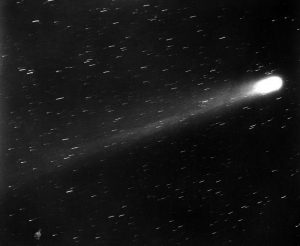
Photographers at the PPIE caught Smith in action by slowing down the speed of their exposure, in order to record the light of his flight over time, just as Barnard had done to photograph a comet. Whereas Barnard moved his camera to follow the motion of the comet, resulting in stars that reproduce as short white lines, these photographers kept their cameras still, allowing the movement of Smith’s plane to draw long white lines in space as he spiralled downward through the single frame of their image. Photographs such as Art Smith and His Trail Across the Sky captured the light of the aviator’s path for spectators long after the performance was over (fig. 1). Taken as the aeroplane twisted and turned through the sky, photographs of Smith flying at night capture a succession of present moments that instantly become the past as soon as they are fixed on the photographic plate.39
Photographs of the night sky were a regular feature at world’s fairs. As art historian Lynda Nead noted:
Astronomy in the nineteenth century was a photographic system of knowledge that expanded the late Victorian visual imagination. It drew on the old magical associations of ancient optical devices, to which it added the wonder of the most recent advances in photography, physics, chemistry, artificial illumination and lens production. It revealed the invisible, it overwhelmed the eye and the mind and could offer to those who desired it unprecedented evidence of a Supreme Intelligence.40

Astronomer William Cranch Bond, who worked at the Harvard Observatory with photographer John Adams Whipple, produced a series of daguerreotypes of the Moon (fig. 6), one of which was awarded a prize at the Crystal Palace Exhibition of 1851. An eclipse that same year offered amateur photographers an unprecedented opportunity to capture its various stages on their plates.41
Later fairs also included presentations of an astronomical nature. At the 1900 Exposition Universelle de Paris, the Celestial Globe and the Great Telescope in the Palace of Optics mixed science and education with entertainment. The Celestial Globe consisted of a gigantic sphere (145 feet in diameter) that was illuminated at night, and was decorated with astronomical symbols. Inside, visitors could climb up to a viewing platform, from which they watched models of the Solar System slowly revolving around them.42 This fascination with astronomy continued at the 1915 PPIE, where “the piece de resistance” [sic] was the twenty-inch equatorial telescope commissioned for the Chabot Observatory, just east of San Francisco.43 Also on view, courtesy of the Dudley Observatory in New York, was “a model of the Taurus cluster, photographs of the southern station at San Luis, Argentina, and a set of photographs and transparencies illustrating star-streaming, absorption of light in space, and kindred phenomena.”44
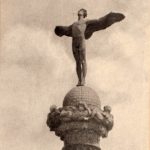
Astronomy was likewise embedded into the architectural fabric of the PPIE. The Court of the Universe, which formed the central axis of the fairgrounds, was flanked at the east and west by two high columns, atop of which stood sculptor Adolph Weinman’s allegories of the rising and setting Sun. The Rising Sun (fig. 7), “a youth with outstretched wings, a figure suggestive of gladness, hope and the dawn of high adventure, is a fitting symbol of the sunrise,” wrote Stella Perry in her guide to sculpture and mural decoration at the fair. Like Smith in his aeroplane, this figure atop his column seemed, in Perry’s words, “a-tiptoe for a flight.”45 The Court itself was surrounded by a Colonnade of Stars, with draped female figures designed by Alexander Stirling Calder placed rhythmically around the long elliptical plaza (fig. 8). “The quiet stars look down upon the activities of men,” continued Perry. “The semi-conventionalized Star figure, light and firm, repeated about the Colonnade is a highly important factor in the architectural beauty of the Court.”46 Standing on a globe that forms her pedestal, “the circle of her arms about the starry head-dress implies the endlessness of space.”47
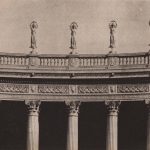
Between the Court of the Universe, with its Colonnade of Stars, and the San Francisco Bay stood the Palace of Agriculture and the Palace of Transportation. Walking between these large buildings and toward the Column of Progress at the edge of the water, visitors entered the Forecourt of the Stars, and looking skyward, viewed low relief friezes of the zodiac (fig. 9). These works, like the Adventurous Bowman atop the Column, were the work of Hermon MacNeil. Perry explicitly connected the heavens, supported by the Greek Titan, Atlas, to time:
Above the central figure of Atlas or Time, his heavenly daughters move, bearing the Zodiacal symbols, to indicate the sweep of the constellations and the onward march of time. This impression of the steady, slow passage of our days is increased by the gentle motion of the figures, so slight as to be felt rather than seen.48
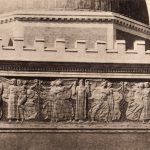
Perry’s description of an “onward march of time,” which began in the distant past and moves in one direction through the present and into the future, differs from MacNeil’s relief, which unfolds compositionally in space from the center toward both left and right. Time moved in a linear manner as well as back and forth at the PPIE.
San Francisco newspapers also featured the subject of astronomy on a regular basis, running articles by astronomers such as Edgar Lucien Larkin, director of the Lowe Astronomical Observatory in southern California. “Billions of Suns Float in Vast Space Deeps” announced the headline of one such article, in which Larkin explained that “between all single suns … the distances are so immense that they are expressed in trillions, hundred of trillions and even by quadrillions of miles.”49 Measuring the distance of a star, continued Larkin in a later column, “so expanded the mind of man that imagination was at once submerged, as it were, and man became a changed being—he became a real thinker and his thoughts rose to hitherto unknown heights.”50 The unsettling juxtaposition of opposites often characterized popular discussions of astronomy in the early twentieth century. Perry and MacNeil together evoked linear and multidirectional conceptions of time in space, whereas Larkin imagined the sky as a place where the mind of man could be simultaneously submerged and rising to a great height.
While the Sun, comets, and the Moon are found within our Solar System, the stars of the zodiac are in other parts of the Milky Way Galaxy, which in 1915 was believed to comprise the farthest reaches of the Universe.51 Barnard, in photographs such as Nebulous Region Near and West of 38 Omicron Persei, a star in the constellation Perseus, depicted these distant astronomical regions (fig. 10).52 In his Photographic Atlas of Selected Regions of the Milky Way, Barnard wrote that
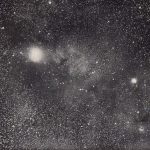
The Milky Way has always been of the deepest interest to me. My attention was first especially attracted to its peculiar features during the period of my early comet-seeking. Indeed, there is no work in observational astronomy that gives one so great an insight into the actual heavens as that of comet-seeking. The searcher after comets sees more of the beauties of the heavens than any other observer. His telescope, though small, usually has a comparatively wide field of view, and is amply powerful to show him most of the interesting parts of the sky. To him the Milky Way reveals all its wonderful structure, which is so magnificent in photographs made with the portrait lens.53
Barnard’s photographs, like the sculpture at the fair, and like Smith in his aeroplane, directed viewers to look up at the stars. And just as Barnard’s photographs of the Milky Way showed parts of the sky too far away to be seen with the naked eye, photographs of Smith flying at night showed patterns not visible during his actual performance. These images helped viewers see and imagine the Universe anew.
Photographs of the stars led to profound musings about space and the time that had elapsed while the light from these distant celestial bodies was traveling to Earth. Astronomy, like photography, brought the past into the present. French astronomer Camille Flammarion, describing in 1894 what is now called “look-back time,” explained it this way:
There is here, then, a surprising transformation of the past into the present. For the star observed, it is the past—already vanished. For the observer, it is the present, the now. The past of a star is strictly and positively the present of the observer… What we believe we see now in the stars is already past; and what is now being accomplished we do not yet see.54
Just as the photographs of Smith flying in his aeroplane captured a succession of present moments that instantly became the past, so too were past, present, and future dialectically linked when looking at the night sky.
Literary critic Eduardo Cadava, in his poetic meditation on Walter Benjamin, photography, and the stars, brings these concepts together, claiming that “the history of photography can be said to begin with an interpretation of the stars.”55 Cadava’s language, like popular discussions of astronomy, is characterized by the juxtaposition of opposites. Photographs, like stars, employ a “language that focuses on the relations between light and darkness, past and present, life and death, reading and writing, and knowledge and representation.”56 Both photographs and the stars are linked to reproduction, Cadava continues, indicating that the light of a person long dead is traced on the surface of a photographic plate, just as the light of a star from millions of years ago is visible in tonight’s dark sky.57
Cadava’s final observations about the stars help connect Smith, his death-defying performances, and their photographic recording with (im)mortality. For “like the photograph that presents what is no longer there, starlight names the trace of a celestial body that has long since vanished. . . . To say that the history of photography begins in the interpretation of stars is to say that it begins in death.”58 Smith used Beachey’s death to enhance the drama of his act. During one night in May, reported The Examiner, the aviator circled three times “and then in an instant the lights were snuffed out. A moment later the motor stopped. An awed stillness spread over the crowd. They expected that the Beachey tragedy was to be re-enacted with the aviator falling to his death through the darkness.”59 Smith restarted the engine and the audience breathed a sign of relief.
Several weeks later, Smith “went up in an aeroplane that was ablaze with fireworks, and before the scores of thousands of men that lined the Marina knew it, the aviator was winding his course among the stars. A few seconds longer and it was literally impossible to distinguish Art Smith’s biplane from the twinkling stars about it.”60 The light of the stars, a trace of the past that exists in the present, was linked to both the light of Smith’s actual celestial body and the writing with light used to produce the photographs of his night flights at the PPIE. Smith, the fairgrounds at which he performed, and the visual culture that documented his performance inspired onlookers in San Francisco to look up at the sky, think about the stars, and move beyond a conventional understanding of linear space and time.
All the Evolutions that Can Be Done Without Going into the Fourth Dimension
It takes only a small leap of the imagination to connect Smith’s fast-moving aeroplane, astronomy, and the camera’s ability to “picture time” with theories of relativity proposed during the first decades of the twentieth century by Albert Einstein.61 But Linda Henderson has conclusively shown that popular references to the fourth dimension from before 1919 usually refer to metaphysical space rather than to special relativity and the space-time continuum. “The fourth dimension was not time but an extra suprasensible dimension of space, of which our three-dimensional world might be merely a section or boundary,” explains Henderson. It was the “‘philosophical and imaginative’ implications of four-dimensional space—primarily as an invisible, higher reality—that had caught the attention of the general public.”62
Edwin A. Abbott popularized the concept of multidimensionality in his 1884 novella about a two-dimensional world called Flatland.63 A square, who serves as the narrator in Abbott’s book, is visited by a sphere from Spaceland. Once awakened to the possibilities of a third dimension, the square begins to imagine a world of four, five, six dimensions, and more. Abbott wrote his novel to critique the rigid social hierarchies of late nineteenth-century England, and the square is ultimately imprisoned for promoting an unorthodox view of the world.
California boasted its own community of intellectuals invested in the notion of the fourth dimension. Cora Lenore Williams, a mathematician and educator with deep interest in the writings of Henri Bergson, also wrote about multidimensional space, connecting the fourth dimension directly to the PPIE. “While many books have been written” about the fair, Williams began her conspicuously titled essay, The Fourth-Dimensional Reaches of the Exposition, “none has succeeded in accounting completely for the joy we have in yonder miracle of beauty.”64
Williams was fascinated by the way in which aviators at the fair drew attention to the possibilities of space. After explaining the first and second dimensions, she noted that
depth and height play little part in our physical perception. For most of us the third dimension is practically unknown beyond the reach of a few feet. A Beachey soaring aloft—why all the bravado of curve and loop? Sooner or later he will fall to his death. Ay, verily! but his is a joyous martyrdom making for the evolution of consciousness. Not always shall we crawl like flies the surface of our globe.65
Exploring space with the aid of an aeroplane, Beachey and Smith functioned as prophets (and potentially, as martyrs) for an imaginative realm of spatial multidimensionality, much like the square in Abbott’s Flatland. Williams, moreover, linked aeronautical performance to an “evolution of consciousness.” Aviators, she suggested, provided a creative link to the fourth dimension, even if they crashed before actually entering it.
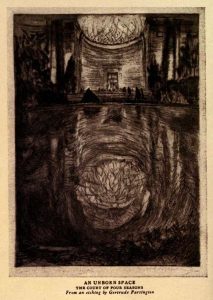
Creative endeavor was deeply embedded in Williams’ book, an all-female production that included a poem by Ormeida Curtis Harrison and prints by Gertrude Partington. The cover was designed by Julia Manchester Mackie. Williams, Harrison, and Mackie were all connected to the active intellectual arts community of Berkeley, California, and Partington was based in San Francisco.66 Partington, who exhibited several paintings at the PPIE, contributed three drypoint etchings to The Fourth-Dimensional Reaches of the Exposition. An Unborn Space depicts the Great Half Dome in the Court of Four Seasons, a monumental architectural recess that provided passage through a rectangular doorway into the Court of Palms (fig. 11). The half dome ceiling was coffered, and a small round reflecting pool stood immediately in front of it. Partington dramatically cropped the structure and relegated it to the top of her etching plate, reserving the larger lower section for the reflection of the dome, swirling gently in the rippling water of the basin. Rational rules of gravity and spatial perspective are collapsed. The viewer floats above the scene, looking simultaneously up toward the rectangular doorway and down into the pool at a spiralling nebula of light and darkness, lines and curves, and sky and stars.
Smith, in a struggle to describe his sensations when performing the “dippy twist,” a “flash-like-cork-screw-spiral,” evoked a similarly disorienting relationship between space and bodily location: “The earth seems to become a jumbled mass of color,” he told a reporter. “While making the swift revolutions I lose all sense of location. I try only to keep account of the number of twists. Too many would cause me to lose consciousness.”67 The redefinition of space was a leitmotif of the PPIE. In addition to watching Smith’s aeronautical performances, visitors delighted in scaled-down, yet still enormous replicas of Yellowstone Park and the Grand Canyon constructed within the fair’s entertainment section, known as The Zone. The Panama Canal, the completion of which provided organizers with the raison d’être of the fair, was likewise reproduced as a five-acre “miniature” within The Zone. And the actual Panama Canal, like an aeroplane, destabilized conventional notions of space (as well as time) by dramatically reducing the number of miles and weeks it took to travel from one part of the globe to another. PPIE displays, in the words of Moore, “functioned as allegories of the ‘real’ landscape they recreated and evoked a sense of sublime wonder and awe” by rendering “the world in gigantic miniature for the privileged viewer.”68
Williams, for her part, linked the reimagining of space and time at the fair to “creative evolution,” the theory of human experience promoted by French philosopher Henri Bergson. Like Smith’s dizzying flight, the exposition contained, according to Williams,
a subtle something not spatialized for consciousness. Length, breadth and height do not suffice to set forth the ways of our delight in it. What of this perceptual residue? Obviously to give it extension we shall have to ascribe to reality other dimensions than those of our present sense-realm. Some disciple of Bergson interrupts: “Ah, this whereof you speak is a spiritual thing and as such is given by the intuition. Why, then do you seek to spatialize it?”… We have to answer that the process of creative evolution makes imperative the transfixion by the intellect of these so-called spiritual perceptions. Although the intuition transcends the intelligence in its grasp of beauty and truth, we may attain to the higher insight it has to offer only if the things of the spirit become known to the intellect—a point in Bergson’s philosophy which the majority of his readers overlook.69
Williams based her reading of Bergson on a series of books popular in the early twentieth century: Time and Free Will (1889), Matter and Memory (1896), and Creative Evolution (1907). Bergsonian time was different from either photographic time or astronomical “look-back” time. Time and Free Will, according to Bergson scholar and art historian Mark Antliff, “described the temporal dimension of human consciousness as synonymous with creative freedom.”70 Time, as Bergson understood it, was subjective and fluid rather than unchanging and fixed. Memories from the past folded into the present, providing a conception of temporality that Bergson called “duration.” Creative Evolution applied these ideas to evolutionary debate and made Bergson into a public celebrity; his books were translated from French and a lecture tour took the philosopher to Italy, England, and in 1913, even to the United States.
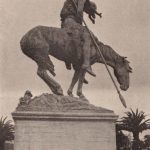
For Williams and her collaborators in the Bay Area, Bergson’s theory of creative evolution provided an alternative to Charles Darwin’s model of biological evolution, as well as Herbert Spencer’s elitist adaptation of Darwinian theory to race and class.71 Spencer’s model, which connected evolution to the progress and triumph of western civilization, was behind the creation of James Earle Fraser’s sculpture The End of the Trail (fig. 12) and Solon Borglum’s Pioneer, both sited prominently on the Avenue of Palms at the PPIE. The End of the Trail depicted, in the words of Stella Perry, “an Indian brave, utterly exhausted, his strong endurance worn through by the long, hard ride… He has come to the end of the trail, beyond which there is no clear path. It is easy to apply the message of this statue to the tragedy of the American Indian’s decline upon the continent he once possessed.”72 “Survival of the fittest,” to use the term coined by Spencer to describe Darwin’s theory, led in this aspect of the sculptural program of the fair to the Indian brave’s exhaustion and replacement by the “lusty and venerable” Pioneer.73
In contrast, Bergson explained the differentiation of species in Creative Evolution by identifying a common point of origin, a creative force that he called the vital impulse or élan vital.74 Diversification had led to two distinct tendencies, one that privileged intelligence, which was dominant in human beings, and the other instinct, was found in nature. Williams associated Bergson’s instinctual realm with the spiritual, arguing that “the process of creative evolution makes imperative the transfixion by the intellect of these so-called spiritual perceptions.”75 Rather than assuming that intellect would inevitably extinguish nature (as in the Spencerian model), creative evolution demanded that the intellect grasp the insights offered by intuitive exploration in order for consciousness-raising to take place. It was the role of the artist (or philosopher) to provoke this dialectic, and the architects responsible for the PPIE, in Williams’ estimation, accomplished this task by defamiliarizing space and bringing the exposition within the imaginative reaches of the fourth dimension. Art Smith, and the photographers who captured his flights in photographs and on film, did so as well.
Like Williams, fairgoers readily linked Smith’s aerial stunts to the artistic and creative realms. Columnists referred to the young aviator as “Art” Smith, placing his nickname in quotation marks. Frank Morton Todd devoted a section in his official history to “flying as an art,” nodding in approval when tablets celebrating aeronautical achievement were mounted on the cornice of the Column of Progress. And Smith began using his plane to draw pictures in the sky.76 By early May, the fearless pilot was writing the word “Zone,” in honor of the fair’s amusement sector, “with smoke pots on the tips of his aeroplane marking his trail across the sky”; he wrote the words “Good-by” in light at night at the end of his first run, in early August.77 “His quick turns and zigzags made the aeroplane resemble a giant, fiery pencil writing across the sky,”78 wrote one journalist.

Most of Smith’s drawings, which are visible only in the photographs that recorded his flight, are abstract. Some are curving and graceful, while others, like Art Smith Over the Battleship Oregon, feature lines that are jagged and abrupt (fig. 13). In this image, the horizontal stability and representational detail of the illuminated battleship at bottom left contrasts with the path of Smith’s aeroplane, characterized by a dynamic downward diagonal, marked by sudden loops, sharp angles, and unexpected changes in direction. These photographs, rather than the paintings and sculpture exhibited in the Palace of Fine Arts, brought abstraction to the public at the PPIE.79
F.R. Ziel is credited with one of the most spectacular of these night images, titled The Trail of the End (fig. 14). The photograph depicts closing ceremonies at the fair, which took place at midnight on December 4, 1915. By playing on the title of Fraser’s sculpture, Ziel made evolution and artistry—both the pilot’s and the photographer’s—its primary subject. A proponent of social Darwinism, prompted by the title, might read Ziel’s photograph as the visual illustration of the technologically savvy white men who overtake and eclipse the uncivilized Indian. Williams, however, could have used Bergson’s theories to create a dialogue between the technologies of aeroplane and camera and the creative intuition of those who manipulate these machines. Smith’s performances, and the images documenting his flights, subverted teleological notions of multidimensional space and evolutionary time in the early twentieth century.
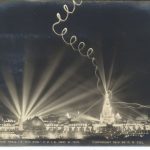
Todd described the dramatic evening in his history, when the lights were extinguished to symbolize the conclusion of festivities:
Not abruptly, but slowly and gently, the lamps grew dark, the beams of the searchlights faded, and arches and courts and colonnades and towers and sculptured forms of men and women and angels and great beasts receded into the friendly night, lighted now by the glimmer of the winter stars, Orion and Sirius, Aldebaran and the Hyades. The last searchlight beam lingered on the beautiful figure of “Descending Night,” but that, too, reluctantly faded away; and through the starlight, “Taps” dropped in liquid notes from bugles high on the Tower of Jewels. The lights came on again, but nevermore the lights of the living Exposition. For that, they spelled “Finis” across the lower gallery of the Tower. Six hundred steel mortars planted along the Marina discharged as many bombs into the air in the most spectacular salvo of fireworks ever seen, and then was heard the welcome whir of “Art” Smith’s engine as his aeroplane glided upward into the velvet sky, to turn over and over in trailing wreaths.80
Smith was flying again, like a comet, toward the stars, and into the Milky Way. The bombs of World War I blasted around him, and funeral wreaths trailed behind. Ziel took his photograph from the hills above the San Francisco Marina, where he could look down on the fairgrounds below. The palaces glow and twinkle, and “the scintillator,” installed by General Electric Company on a barge in the Bay, projects its battery of searchlights up toward Smith and out into the Universe. Its light might reach the stars someday in the future. Smith is in evolution, readying to enter the fourth dimension, and the photographer has opened his lens to record his spiralling descent, a ribbon of loops playfully circling the tip of the Tower of Jewels before heading toward the right, only to return, again.
Acknowledgements
Portions of this essay were delivered at the Nineteenth Century Studies Association annual conference on “Loco-Motion,” March 2012, in Fresno, California. The authors appreciated the comments from the audience, as well as the excellent feedback provided by the editors and anonymous readers of Panorama. We also wish to acknowledge the assistance of Marco Katz Montiel, Andrea Korda, and undergraduate research assistant Julie-Ann Mercer. Astronomical guidance was provided by Joseph C. Boone, Professor Emeritus of Physics, California Polytechnic State University, San Luis Obispo. Research funding for this project was provided by the Social Sciences and Humanities Research Council of Canada (SSHRC).
DOI: https://doi.org/10.24926/24716839.1501
PDF: Boone and Belanger: “Art” Smith, Flying at Night, and the 1915 San Francisco World’s Fair
Notes
- Film historian Tom Gunning aptly observes that new technologies “announced key aspects of modernity: an overcoming of space and time that allowed a new sense of the global in a world shrunken by new technologies of transportation and communication; a demonstration and, nearly, the deification of new sources of energy and power, … a narrative of progress exemplified by a series of new technological devices and goods placed on display in order to launch them into the world of newly created consumers; and last, but not least, a mode of highly stimulated spectatorship in which huge crowds were encouraged to envision a future that would be simultaneously spectacular and convenient.” See Gunning, “Re-Newing Old Technologies: Astonishment, Second Nature, and the Uncanny in Technology from the Previous Turn-of-the-Century,” in Rethinking Media Change: The Aesthetics of Transition, eds. David Thorburn and Henry Jenkins (Cambridge: MIT Press, 2003), 39–40. ↵
- Frank Morton Todd, The Story of the Exhibition, vol. 3 (New York: G. P. Putnam Sons, 1921), 42. ↵
- Linda Dalrymple Henderson, The Fourth Dimension and Non-Euclidean Geometry in Modern Art, rev. ed. (Cambridge: MIT Press, 2013); and Kathleen A. Pyne, Art and the Higher Life: Painting and Evolutionary Thought in Late Nineteenth-Century America (Austin: University of Texas Press, 1996). ↵
- Mark Antliff, Inventing Bergson: Cultural Politics and the Parisian Avant-Garde (Princeton, NJ: Princeton University Press, 1993). ↵
- The secondary literature on world’s fairs, much of it inspired by Robert Rydell’s groundbreaking work, is immense. See Rydell, All the World’s a Fair: Visions of Empire at American International Expositions, 1876–1916 (Chicago: University of Chicago Press, 1984). On the 1915 San Francisco Fair, see the essays in Burton Benedict, et al. The Anthropology of World’s Fairs: San Francisco’s Panama-Pacific International Exposition, 1915 (Berkeley: Scolar Press, 1983); Keith L. Eggener, “Maybeck’s Melancholy: Architecture, Empathy, Empire, and Mental Illness at the 1915 Panama-Pacific International Exposition,” Winterthur Portfolio 29 (Winter 1994): 211-12; Laura Anne Ackley, “Innovations in Illumination at the Panama-Pacific International Exposition,” MS thesis, University of California, Berkeley, 2002; Michael Leja, “Progress and Evolution at the US World’s Fairs, 1893–1915,” Nineteenth-Century Art Worldwide 2, no. 2 (Spring 2003), http://www.19thc-artworldwide.org/, accessed March 31, 2014; William Lipsky, San Francisco’s Panama-Pacific International Exposition (Charleston, SC: Arcadia Publishing, 2005); Noelle Belanger, “Time and Technology at the Panama-Pacific International Exposition,” MA thesis, University of Alberta, 2013; and Sarah J. Moore, Empire on Display: San Francisco’s Panama-Pacific International Exposition of 1915 (Norman: University of Oklahoma Press, 2013). ↵
- Rachel S. Roberts, Art Smith: Pioneer Aviator (Jefferson, NC: McFarland, 2003), 77. ↵
- Todd, The Story of the Exhibition, vol. 2, 19 and 181. ↵
- Ibid., vol. 3, 19. ↵
- Charles Niles and Silvio Pettirossi were later hired to perform as aviators at the PPIE, but Katherine Stinson, who also applied, was not. In a letter to Stinson’s agent from September 24, 1915, the Special Events Department made clear an unwillingness to hire a woman: “I could not seem to get anybody interested in your star on account of being a woman and you know how ‘panicky’ the Committees are around here for aviators anyway, to say nothing of lady aviators.” PPIE Records, Bancroft Library, University of California, Box 92, folder 1 (Aviation). ↵
- Roberts, Art Smith, 81. ↵
- “Remarkable Night Picture of Aviator Art Smith,” Oakland Enquirer, July 30, 1915. The photographer of this “first successful attempt” was not recorded by the newspaper. ↵
- Art Smith’s Story: The Autobiography of the Boy Aviator Which Appeared as a Serial in The Bulletin, ed. Rose Wilder Lane (San Francisco: The Bulletin, 1915), 3. ↵
- Art Smith’s Story, 3–4. ↵
- Timothy Mitchell, “The World as Exhibition,” Comparative Studies in Society and History 31 (April 1989): 217–36. ↵
- Additional images of Art Smith at Fort Winfield Scott may be viewed by searching the Allen County Digital Collections at http://contentdm.acpl.lib.in.us/cdm/, accessed October 11, 2014. ↵
- Patricia Junker examines the impact of the Lusitania attack on the fine arts in “Childe Hassam, Marsden Hartley, and the Spirit of 1916,” American Art 24, no. 3 (Fall 2010): 33–34. ↵
- Art Smith’s Story, 84. Although PPIE organizers had originally envisioned a “Round the World Air Race,” scheduled to begin at the fairgrounds on May 15, 1915, this was cancelled as a result of the war. See PPIE Records, Bancroft Library, University of California, Box 12, folder 8 (Aeronautics, Round the World Race). ↵
- “Art Smith Sets Hearts Leaping,” San Francisco Examiner, May 3, 1915, 6. ↵
- “Ship to be Blown Up by Mine in Bay for Zone Day,” San Francisco Examiner, May 24, 1915, 7. ↵
- “Women Faint as Airship is ‘Blown Up,’” San Francisco Examiner, May 27, 1915, 13. ↵
- Ibid. Smith continued his war-inspired antics throughout his run. For example, July 24 featured a “Battle of the Marina,” followed by “Art Smith Dropping Bombs from his Aeroplane.” See “Land and Sea Force to Clash at Fair,” San Francisco Examiner, July 14, 1915, 9; and “Army and Navy Sports to be Big Feature in Celebration of the ‘Newspapermen’s Day’ at the Exposition,” Sausalito News, July 17, 1915. ↵
- On Nadar, photography, and aeronautics, see Julian Barnes, Levels of Life (New York: Alfred A. Knopf, 2013). ↵
- John H. Morrow, Jr., “The First World War, 1915–1919,” in A History of Air Warfare, ed. John Andreas Olsen (Washington, DC: Potomac Books, 2010), 6. ↵
- Alan C. Braddock, “Poaching Pictures: Yellowstone, Buffalo, and the Art of Wildlife Conservation,” American Art 23, no. 3 (Fall 2009): 48–49. See also Alan C. Braddock, “Shooting the Beholder: Charles Schreyvogel and the Spectacle of Gun Vision,” American Art 20, no. 1 (Spring 2006): 36–59. ↵
- Marey’s “gun” included a rotating disk that could record twelve images on a single plate at a speed rapid enough to photograph a bird in flight. See Marta Braun, “The Expanded Present: Photographing Movement,” and Ann Thomas, “Capturing Light: Photographing the Universe,” in Beauty of Another Order: Photography in Science, ed. Ann Thomas (New Haven: Yale University Press in association with the National Gallery of Canada, 1997), 151–57, 192. See also Jimena Canales, “Photogenic Venus: The ‘Cinematographic Turn’ and Its Alternatives in Nineteenth-Century France,” Isis 93, no. 4 (December 2002): 588. ↵
- Bird’s eye views were produced as early as classical antiquity. For a selection of recent essays on the subject, see Mark Dorrian and Frédéric Pousin, eds., Seeing from Above: The Aerial View in Visual Culture (London: I.B. Tauris, 2013). ↵
- See Alan Wallach, “Making a Picture of the View from Mount Holyoke,” Bulletin of the Detroit Institute of Arts 66, no. 1 (1990): 34–45; Albert Boime, The Magisterial Gaze: Manifest Destiny and American Landscape Painting (Washington, DC: Smithsonian Institution Press, 1991); and Angela L. Miller, The Empire of the Eye: Landscape Representation and American Cultural Politics, 1825–1875 (Ithaca: Cornell University Press, 1993). ↵
- Moore, Empire on Display, 7. ↵
- “Art Smith Will Soar To-Day in Oratory and Airship,” San Francisco Examiner, May 1, 1915, 3. ↵
- Hauus Guenther, “How the Airmen Talk with the Earth,” San Francisco Examiner, April 11, 1915, 76. Flags were also used to signal information from aerial balloons and other reconnaissance devices. ↵
- Morrow, “The First World War,” 12.
Trick flying, such as that mastered by Smith, was readily adapted to combat situations. Later, when the United States joined the war in 1917, the plucky stunt pilot trained and tested airmen in the military who were heading overseas.[33. Sources claim that Smith was prevented from enlisting for active duty either because of his small height or because of injuries he had sustained during his career as a trick pilot. Roberts, Art Smith, 135, and Robert W. Bowen, San Francisco’s Presidio (Charleston, SC: Arcadia Publishing, 2005), 62. ↵
- People today experience war through similarly mediated media on TV, in news magazines, and even through video games. Photographs of the “Shock and Awe” campaign published in major magazines reporting on the 2003 United States invasion of Iraq functioned in this way. ↵
- Marta Braun, “Time and Photography,” in Tempus Fugit: Time Flies, ed. Jan Schall (Kansas City: The Nelson-Atkins Museum of Art, 2000), 132. ↵
- See the two film clips of Smith performing at night in the Prelinger Archive online at the Internet Archive (www.archive.org): Gould can 5390.1 and Gould can 5202.5. The footage of Smith at the end of the first film, which is silent, is titled “Art Smith / Worlds Gratest Aviator / looping the loop and dropping / bombs in his illuminated / night flight” {sic}. The clips in the second film were shot in 1915 and rereleased in a newsreel from 1939, on the eve of World War II, thereby underscoring the metaphorical relationship between Smith’s flights and military engagement. San Francisco held its second world’s fair in the midst of this second conflict, from 1939 to 1940. ↵
- “Smith Gyrates in Rainstorm,” San Francisco Examiner, May 5, 1915, 7. ↵
- “Joy Festival Carried Far into Night,” San Francisco Examiner, May 28, 1915, 13. ↵
- “Aviator Defies Wind’s Pranks,” San Francisco Examiner, May 8, 1915, 13; “Smith ‘Drops from the Heavens,’” San Francisco Examiner, May 14, 1915, 6; and “Art Smith Thrills Crowds on Marina,” San Francisco Examiner, May 21, 1915, 11. ↵
- Barnard made his first astronomical photographs while working at Lick Observatory, sited east of San Jose atop Mount Hamilton, from 1887 until 1895. He published a number of these images in Photographs of the Milky Way and of Comets {Publications of the Lick Observatory, vol. 11} (Sacramento: F. W. Richardson, 1913). Barnard joined the faculty at the University of Chicago in 1895, where he had access to Yerkes Observatory in Williams Bay, Wisconsin, and most of the photographs in his posthumously published life’s work, A Photographic Atlas of Selected Regions of the Milky Way (Washington, DC: Carnegie Institution of Washington, 1927), were produced there and at Mount Wilson Observatory, in southern California. For a comprehensive analysis of Barnard’s career, see William Sheehan, The Immortal Fire Within: The Life and Work of Edward Emerson Barnard (Cambridge: Cambridge University Press, 1995). ↵
- Braun makes a related observation about photographs taken with very short exposure times. “Yet even though photography continues to astound us with its ability to picture smaller and smaller increments of time, that time is always the moment in which the photograph is taken, the ‘now’ that, when we see the printed photograph, instantly becomes ‘then.’” See Braun, “Time and Photography,” 132. ↵
- Lynda Nead, The Haunted Gallery: Painting, Photography, Film (New Haven: Yale University Press, 2007), 203. ↵
- Ibid., 207; see also Thomas, “Capturing Light,” 197. ↵
- Nead, The Haunted Gallery, 224. ↵
- Heber D. Curtis, “Astronomical Exhibits at the Exhibition,” Publications of the Astronomical Society of the Pacific 27, no. 159 (June 1915): 105. ↵
- Ibid., 109. ↵
- Stella G. S. Perry, The Sculpture and Mural Decorations of the Exposition (San Francisco: Paul Elder, 1915), 62. ↵
- Perry, The Sculpture and Mural Decorations of the Exposition, 50. ↵
- Ibid. ↵
- Ibid, 54. Perry conflates Atlas, who was forced to hold up the heavens as punishment for fighting against the Olympians, with Kronos, the mythological god of time and the ages. ↵
- “Billions of Suns Float in Vast Space Deeps,” San Francisco Examiner, April 1, 1915, 30. ↵
- “Astronomy, the Most Majestic Science,” San Francisco Examiner, May 7, 1915, 20. Larkin also published “Mystery of the Stars, Comets and Suns,” San Francisco Examiner, April 10, 1915, 20, and “Astronomer’s Toil Most Severe of All,” San Francisco Examiner, June 18, 1915, 20. ↵
- Edwin Hubble proved the existence of other galaxies in 1922 by showing that several spiral nebulae, Andromeda and Triangulum, were too far away to be in the Milky Way. See http://spacechronology.com, accessed April 7, 2014. ↵
- Barnard spends the first two paragraphs of the article reproducing this image discussing the relative merits of telescopes and photography. See E. E. Barnard, “A Great Nebulous Region Near Omicron Persei,” The Astrophysical Journal 41 (May 1915): 253–60. ↵
- E. E. Barnard, “Introduction,” A Photographic Atlas of Selected Regions of the Milky Way, vol. 1, n.p. ↵
- Flammarion, Popular Astronomy: A General Description of the Heavens (1894), 616–17; original emphasis, cited in Nead, The Haunted Gallery, 230. ↵
- Eduardo Cadava, “Stars,” in Words of Light: Theses on the Photography of History (Princeton, NJ: Princeton University Press, 1997), 26. ↵
- Ibid. ↵
- Roland Barthes uses a photograph of his deceased mother to muse on a related subject. See Barthes, Camera Lucida (New York: Hill and Wang, 1981). ↵
- Cadava, “Stars,” 30. ↵
- “Horror Thrill Given Crowd by Art Smith,” San Francisco Examiner, May 1, 1915, 1. ↵
- “Great Free Exposition Show Given,” San Francisco Examiner, May 15, 1915, 6. Smith’s actual death on February 12, 1926, was rather prosaic; he joined the United States Air Mail Service after the war and strayed off course during a routine run from Chicago. Mistaking a lighted farmhouse for the airfield in Bryan, Ohio, he hit a tall tree while circling the area in search of the runway. Roberts, Art Smith, 142–44. ↵
- Einstein introduced his special theory of relativity to the scientific community in 1905; his teacher Hermann Minkowski demonstrated the theory geometrically two years later. ↵
- Henderson, The Fourth Dimension and Non-Euclidean Geometry, 2. ↵
- Edwin A. Abbott, Flatland: An Edition with Notes and Commentary, eds. William F. Lindgren and Thomas F. Banchoff (1884; reprint, Cambridge: Cambridge University Press, 2010). ↵
- Cora Lenore Williams, The Fourth-Dimensional Reaches of the Exposition (San Francisco: Paul Elder, 1915), 2. ↵
- Williams, The Fourth-Dimensional Reaches, 5. ↵
- For biographical information on Gertrude Partington, who married and became Gertrude Partington Albright in 1917, see “Gertrude Partington Albright,” California Art Research 15 (1936–37): 31–54; Doris Ostrander Dawdy, Artists of the American West: A Biographical Dictionary, vol. 1 (Chicago: The Swallow Press, 1974), 6–7, and Jules and Nancy Heller, eds., North American Women Artists of the Twentieth Century (New York: Garland, 1995), 15. ↵
- “Art Smith is Back; Gives New Thrills,” San Francisco Examiner, November 8, 1915, 5. ↵
- Moore, Empire on Display, 8–9. ↵
- Williams, The Fourth-Dimensional Reaches, 2–3. ↵
- Mark Antliff, “Creative Time: Bergson and European Modernism,” in Tempus Fugit: Time Flies, 37. ↵
- Leja concisely differentiates Darwinian from Spencerian evolution in “Progress and Evolution.” Citing Pyne, Leja explains that “Spencer’s views were favored among American elites at the turn of the century, because ‘his thought buttressed {their} inherited ideology… in both its socioeconomic aspects and its religiophilosophical aspects.’ Spencer legitimated the identification of evolution with progress within an unreconstructed Protestant world view.” ↵
- Perry, The Sculpture and Mural Decorations of the Exposition, 36. ↵
- Ibid., 34. ↵
- This explanation of creative evolution is derived from Leonard Lawlor and Valentine Moulard Leonard, “Henri Bergson,” The Stanford Encyclopedia of Philosophy (Winter 2013 Edition), Edward N. Zalta (ed.), URL = http://plato.stanford.edu/archives/win2013/entries/bergson/, accessed August 12, 2014. See also Jane Bennett, Vibrant Matter: A Political Ecology of Things (Durham, NC: Duke University Press, 2010), 76–81. ↵
- Williams, The Fourth-Dimensional Reaches, 2. ↵
- The first time the flier’s name appears in The Examiner as “Art” Smith is in “Art Smith to Fly at Fair To-Morrow,” San Francisco Examiner, April 22, 1915, 13. Todd discusses “flying as an art” in Story of the Exposition, vol. 3, 84. ↵
- “Art Smith to Go the Limit,” San Francisco Examiner, May 7, 1915, 7, and “‘Good-by,’ Writes Art Smith in Air,” San Francisco Chronicle, August 9, 1915, 4. A print of Smith writing goodbye is in the San Francisco Historical Photograph Collection at the San Francisco Public Library, AAE-0811. ↵
- “Art Smith Makes Spectacular Flight,” San Francisco Examiner, May 31, 1915, 6. ↵
- Most of the work in the Palace of Fine Arts, with the notable exception of the gallery of Italian Futurists, was produced in the academic and impressionist modes. On the futurists at the PPIE, see Belanger, “Time and Technology,” chap. 2. ↵
- Todd, Story of the Exposition, vol. 5, 230. ↵
About the Author(s): Noelle Belanger is a PhD candidate at the University of Illinois at Urbana-Champaign, and M. Elizabeth Boone is Professor of History of Art, Design, and Visual Culture, University of Alberta.

